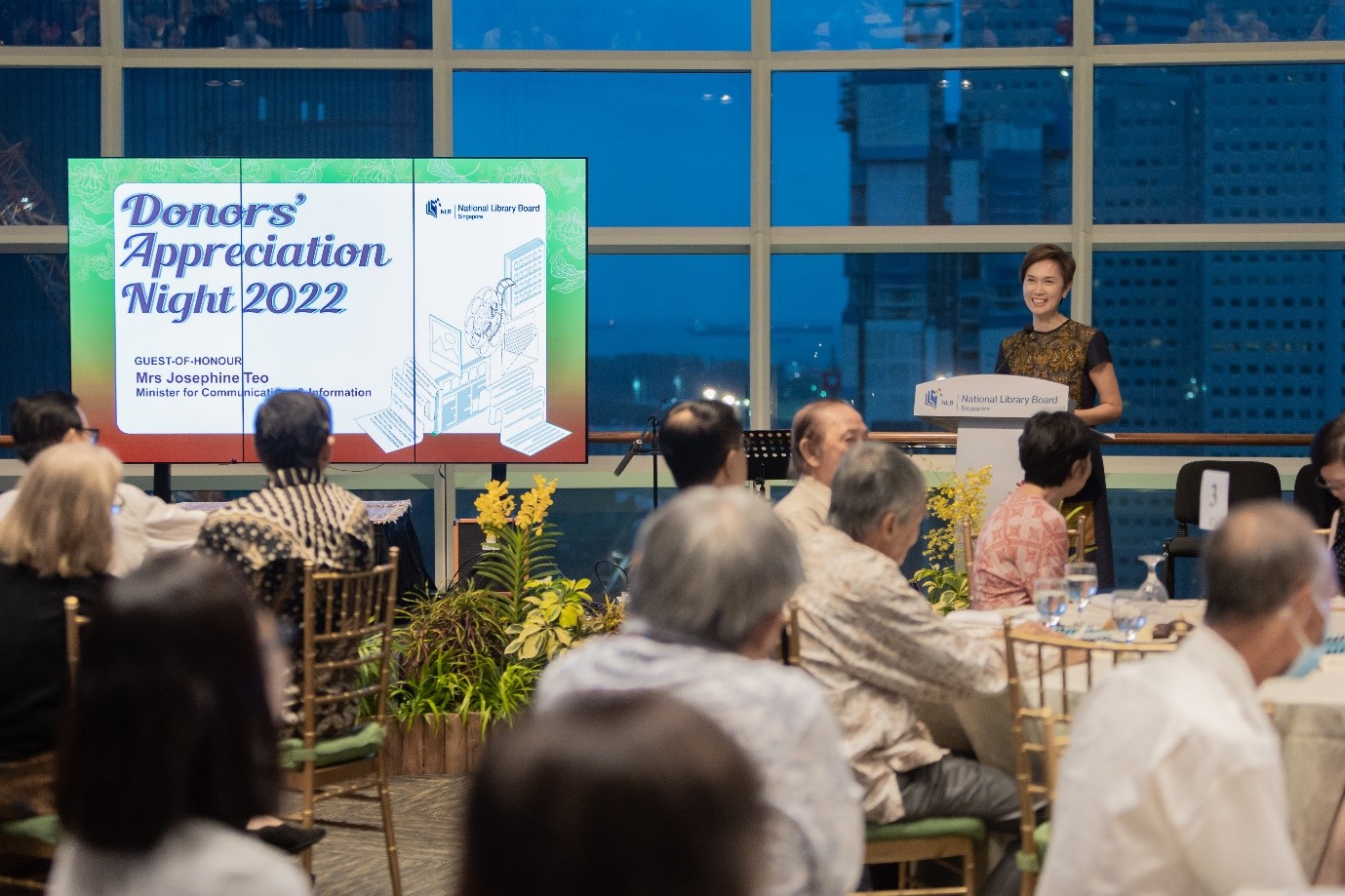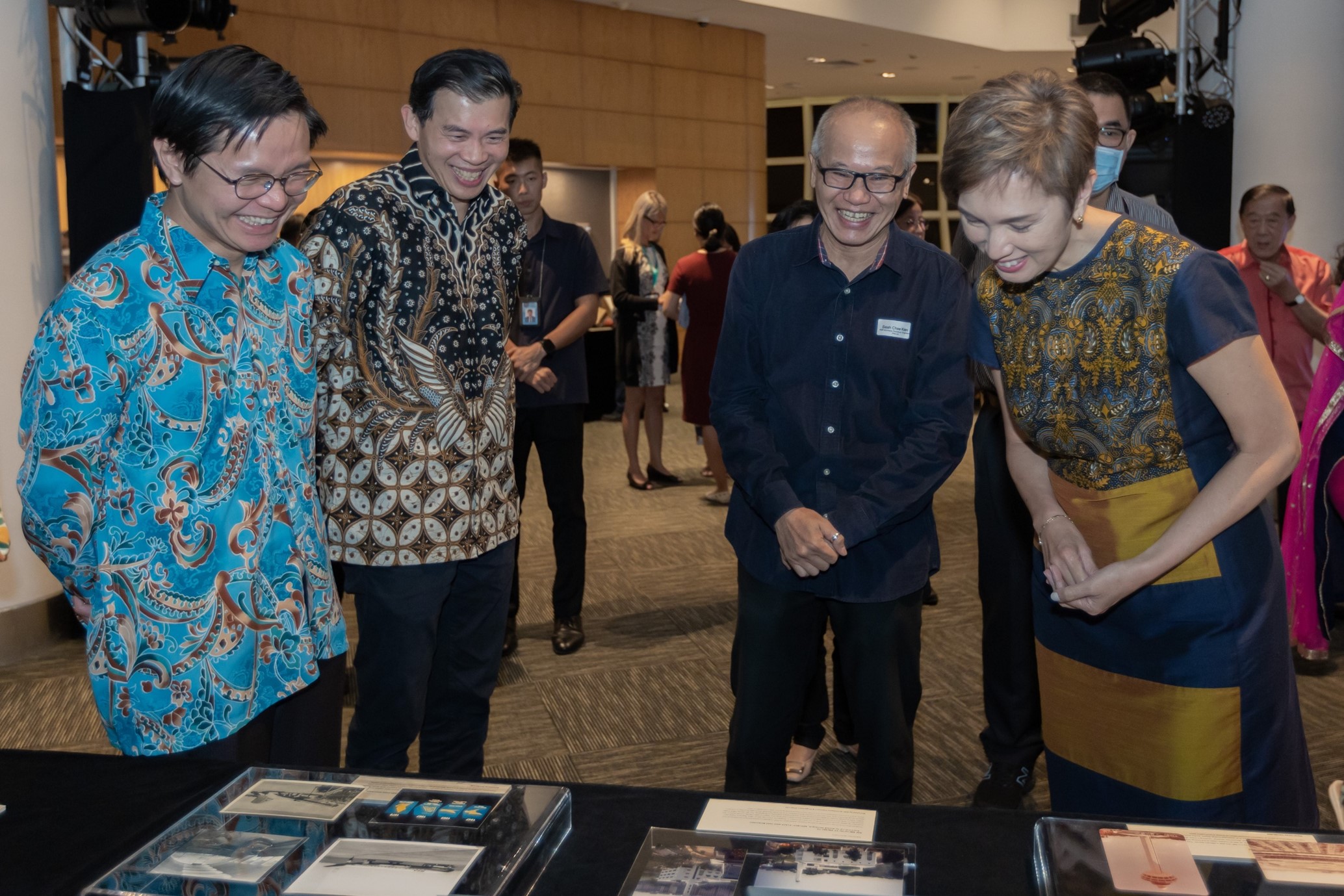Donors Add More Than 3000 New Items To NLB's Collections For All To Discover And Learn From
Donors' contributions enrich stories about Singapore's heritage and history
Singapore, 14 September 2022 – Everyone can now learn and discover more about Singapore’s history and heritage through the more than 3,000 heritage items donated to the National Library Board (NLB) between April 2021 and March 2022. These contributions from 68 donors to the National Library (NL) and the National Archives of Singapore’s (NAS) collections present rich and diverse perspectives on Singapore’s history and heritage, revealing some lesser known details about the nation’s past. The donated items include manuscripts by literary pioneers, letters, and art prints relating to the Japanese Occupation in Singapore.
The strong support and generous contributions of donors are instrumental to NLB’s LAB25 (Libraries and Archives Blueprint 2025) Singapore Storytellers role to nurture a stronger appreciation and understanding of our collective experience. At NLB’s Donors’ Appreciation Night held today, NLB thanked its donors, including those who had donated their collections in the past year, for their invaluable contributions. The physical event, the first to be organised since the pandemic started in 2020, brings together the community of NLB’s donors.
NLB will explore more ways to share stories about its collections, including the new items, through various ways, such as exhibitions at new and revamped libraries. The public can also look forward to more opportunities to contribute their Singapore stories, including through the online crowdsourcing platform, “Documenting Singapore Together”, an expansion on NAS’s Citizen Archivist project, to be launched in 2023. The public can submit their own contributions about Singapore through this platform (e.g. digital items like images and videos), as well as lend their expertise to enhance the discoverability of the NLB’s collections, through description, transcription, translation and transliteration of heritage material. More details will be shared when ready.
At the event, the Guest-of-Honour, Minister for Communications and Information Mrs Josephine Teo, thanked the donors for their invaluable contributions to NLB’s collections. She said: “I am heartened to see donors and members of the public working together with NLB to collect and preserve precious heritage materials, and inspire future generations of Singapore storytellers. This is in line with one of NLB’s roles under LAB25 of inspiring Singapore Storytellers by nurturing a stronger appreciation and understanding of Singapore’s heritage and identity. We are all Singapore Storytellers and our experiences add to our collective memory of what it means to be Singaporean.”
NLB’s Chief Executive Officer, Mr Ng Cher Pong said: “NLB’s collection is vast and rich, in large part due to the generosity of our donors over the years. We are truly grateful for their unwavering support and partnership. Researchers and members of the public can look forward to more discoveries from our enriched collections, to discover and learn about Singapore’s heritage and identity. In turn, we can all be Singapore Storytellers, to share Singapore stories and to connect with one another.”
Patrons may access NL and NAS’s collections via the following online platforms:
- Archives Online (https://www.nas.gov.sg/archivesonline/)
- BookSG (https://eresources.nlb.gov.sg/printheritage/)
- PictureSG (https://eresources.nlb.gov.sg/pictures/)
- NewspaperSG (https://eresources.nlb.gov.sg/newspapers)
- Web Archive Singapore (https://eresources.nlb.gov.sg/webarchives/landing-page)
- National Online Repository of the Arts (https://eresources.nlb.gov.sg/arts/website/Common/Homepage.aspx)
Please refer to the Annex for details and photos of several key donations received from April 2021 to March 2022, which were on display at the Donors’ Appreciation Night.
Minister for Communications and Information Mrs Josephine Teo, NLB’s Chairman Mr Lee Seow Hiang and NLB’s Chief Executive Officer Mr Ng Cher Pong at the Donors’ Appreciation Night on 14 September 2022. [Photo credit: National Library Board]
– END –
About National Library Board
The National Library Board (NLB) nurtures Readers for Life, Learning Communities and a Knowledgeable Nation by promoting reading, learning and history through its network of 28 libraries, the National Library and the National Archives of Singapore. NLB also forges strategic partnerships that encourage awareness, appreciation and greater discovery of Singapore’s history through its rich collections on Singapore and the region.
NLB achieves excellence through innovation, focusing on citizen engagement and co-creation, resource and digital innovation. This creates learning opportunities, greater access to library resources, services and archival collections, as well as a continual development of innovative library spaces. Established on 1 September 1995 as a statutory board, NLB is under the Ministry of Communications and Information (MCI).
For more information, please visit the NLB website, and NLB’s Facebook, Instagram, LinkedIn and YouTube channels.
For media enquiries, please contact:
Denise Yuen Joween Song
Weber Shandwick Weber Shandwick
Tel: +65 9478 7377 Tel: +65 9677 2598
Email: dyuen@webershandwick.com Email: jsong@webershandwick.com
LIST OF SELECTED ITEMS FROM NLB’S COLLECTIONS ON DISPLAY AT THE DONORS’ APPRECIATION NIGHT EVENT
| S/N | Image Reference | Donations Highlight | Description |
|
1 |
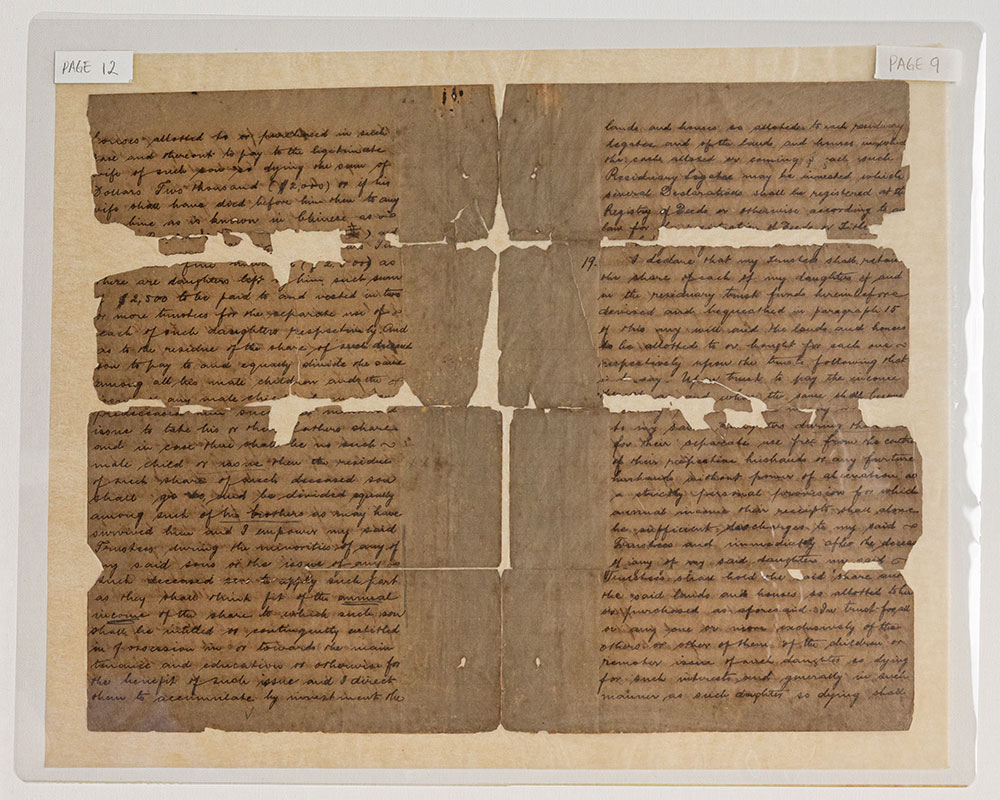 |
A collection of wills, legal and business documents belonging to Mr Cheang Hong Lim, a Hokkien businessman and philanthropist, and other members of his family, with most dating from the 19th century to early 20th century. Donated by the Family of Mr Cheang Theam Kee, the grandson of Mr Cheang Hong Lim. (Total number of donated items: 35) |
The materials provide a record of the familial relations and the extent of the estate and business activities of one of the leading Chinese families in colonial Singapore. This includes an early 20th century copy of the will of Mr Cheang Hong Lim, which is broadly organised into two parts. The first half concerns the distribution of Mr Cheang’s properties in China to his natural-born sons, while the latter half left instructions for his funeral rites to be carried out in strict accordance with Chinese religious customs and for his body to be interred in the family tomb. It also details how his vast estate outside of China was to be distributed among his legal wives, sons and daughters in Singapore. Though the arrangements largely reflect the traditional patriarchal Chinese family system, the will interestingly makes provisions for his daughters to receive personal income that they could use, free from the control of their husbands. |
|
2 |
 |
Material relating to the Singapore Chinese Medical Union (SCMU), including minutes of meeting from their founding years, records of member physicians, accounts books, ephemera and publications dating back to 1929. Donated by Singapore Chinese Medical Union. (Total number of donated items: 103) |
SCMU was formed in 1929 and has a long history of contributing to the development and improvement of Traditional Chinese Medicine in Singapore. One of the donated items, a SCMU members’ register, contains a registry of members comprising Chinese medical physicians and shops from 1929 to 1958, as well as rules and regulations for their members. These included regulations relating to matters such as the advertising of their products and services. To regulate and develop Traditional Chinese Medicine in Singapore, a committee was set up for the surveillance of Chinese medical products and physicians at the time of founding in 1929 which included prominent leaders in the Chinese community, such as Mr Tan Kah Kee (陈嘉庚) and Mr Aw Boon Haw (胡文虎) under the name of Mr Eng Aun Tong (永安堂), the Chinese medical halls which he owned. |
|
3 |
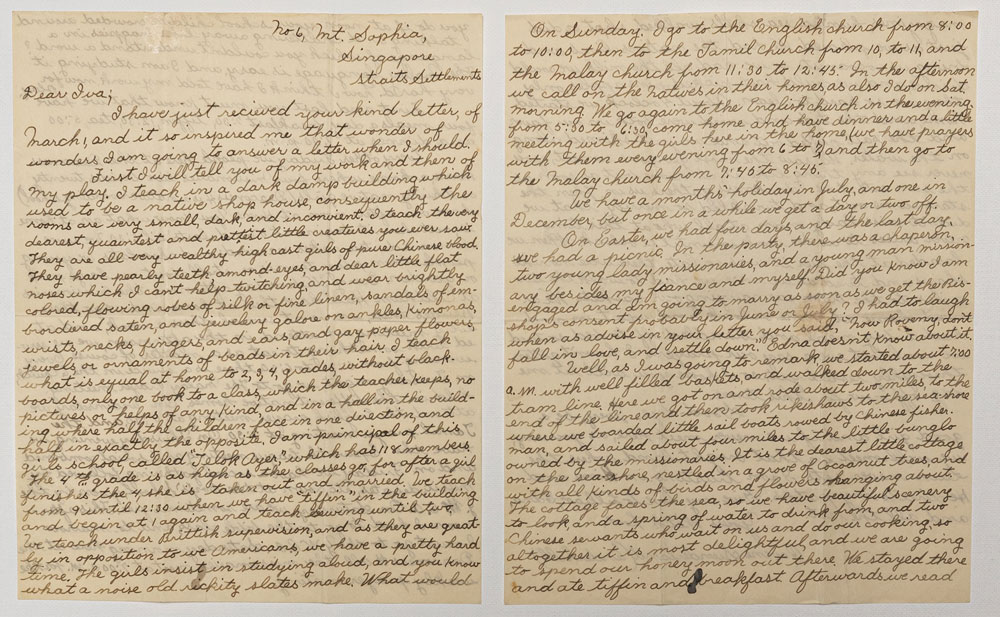 |
A handwritten letter dated circa 1909 by Ms Rovene Sunderland, who worked in Singapore as an American missionary teacher at Telok Ayer Girls’ School, founded by Ms Sophia Blackmore in August 1888. Donated by Ms Marilyn Finn. |
In the letter addressed to her friend in USA, Ms Sunderland describes her experiences and observations as a teacher at Telok Ayer Girls’ School, such as the students’ attire, their meals as well as the daily schedule she and the other missionary teachers kept. Ms Sunderland was born in Indiana, USA in December 1886, came to Singapore in 1909 and most likely left after a year. Although the letter is undated, it is estimated to have been written around 1909. The donor, Ms Marilyn Finn who is based in Illinois, USA, chanced upon the letter during the COVID-19 pandemic while she was going through the boxes of papers kept in her attic by the previous owner of her house. Recognising the historical significance of the letter, she donated the letter to NLB. |
|
4 |
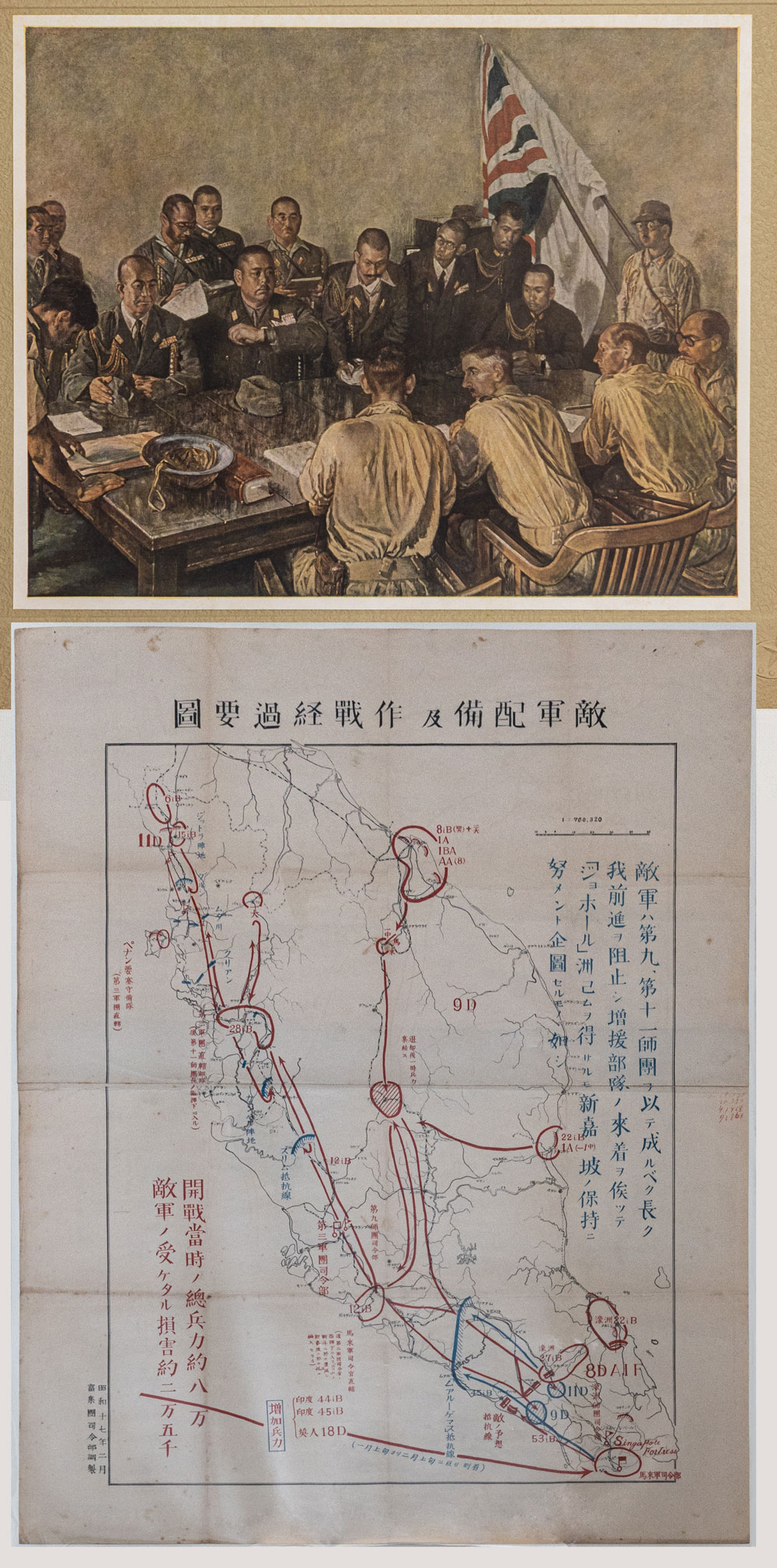  |
Books, serials, maps, pictures, ephemera and art prints, dated between 1910 and 2005, relating to pre-war Japanese presence in Southeast Asia, the Japanese military campaign and their subsequent occupation of Southeast Asia during WWII. Donated by Mr Lim Shao Bin, a private collector and researcher. (Total number of donated items: 280) |
The items include a set of 23 art prints of Japanese war art, published by the Army Art Association of Japan in 1943, which documented the Greater East Asia War that was waged in the Pacific Theatre during World War II. These state-sponsored art portrayed battle situations and military victories, including a print of the iconic painting “The Meeting of General Yamashita and General Percival” – British surrender of Singapore on 15 February 1942. There is also a map, dated 1942, of the Malaya campaign prepared by the Japanese 25th Army in February 1942. It details the locations, movements and areas of resistance mounted by the British, Indian and Australian units of the Malaya Command. The map also notes the losses sustained by the Commonwealth forces, the capitulation of Johore, and that Singapore remained as one of the last British bastions to be conquered in the Japanese Army’s southward advance. The donations also include 139 of the 370 issues of Shashin Shūhō, a widely circulated World War II-era propaganda organ published by the Cabinet Intelligence Department of Japan between 1937 and 1945. The weekly periodical is richly illustrated with photographic images that chronicled Japan’s military actions in East and Southeast Asia, and was highly effective in its use of photojournalism to promote Japan’s war-time agenda and to boost nationalistic sentiments. They serve as an important visual record of the battle and fall of Singapore as documented by invading Japanese forces. |
|
5 |
 |
Handwritten manuscripts and typescripts of Tamil short stories and radio plays written by literary pioneer Mr Se Ve Shanmugam in the 1970s and 1980s. Donated by the Family of the late Mr Se Ve Shanmugam (Total number of donated items: 72) |
Mr Se Ve Shanmugam is one of Singapore's Tamil literary pioneers who has written short stories, plays, poems, essays and novels. He won many accolades and was nicknamed Singapore’s George Bernard Shaw by the Tamil community for his contributions to literature and his humorous writing style. One of the manuscripts published in 1968 is his first book of short stories. Mr Shanmugam is known for his humorous stories that are based on the common experiences of the Tamil community in 1960s Malaya. One story in this book tells of a man who boasted to his neighbour that he had bought fish for a dollar when he had in fact paid two dollars and fifty cents. The wily neighbour then takes advantage of him and asks him to buy fish for her every week. |
|
6 |
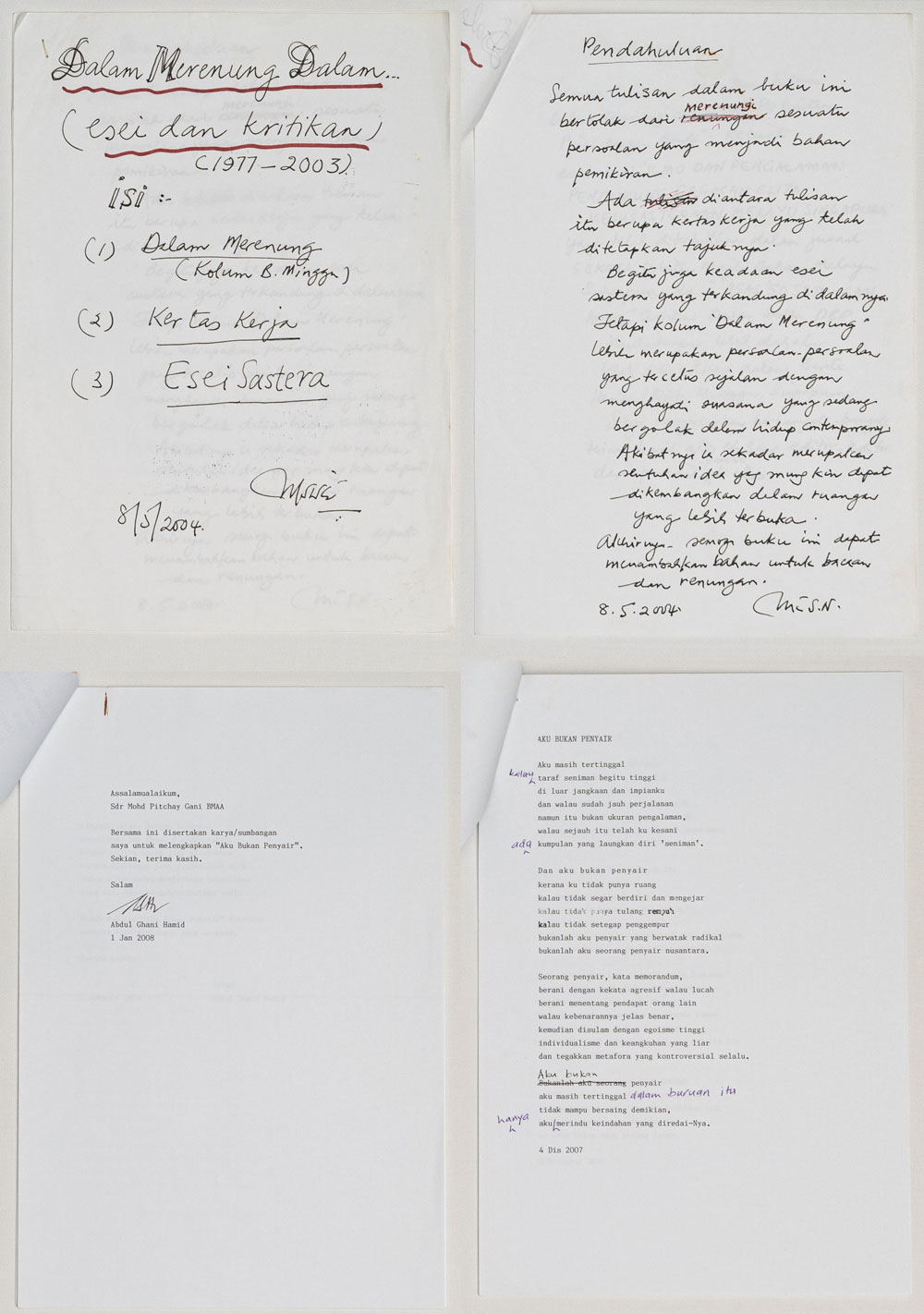 |
Personal documents, manuscripts and typescripts of several Malay literary pioneers, such as the late Mr Abdul Ghani Hamid, the late Mr Aliman Hassan and others, who had worked with Dr Mohamed Pitchay Gani Bin Mohamed Abdul Aziz on various publication projects and presentations over the years. Donated by Dr Mohamed Pitchay Gani Bin Mohamed Abdul Aziz, writer, editor and past president of Angkatan Sasterawan ’50, a Singapore Malay writers’ movement. (Total number of donated items: 76) |
The collection includes manuscripts and typescripts relating to the last published works of two Malay literary pioneers, Mr Masuri S.N. and Mr Abdul Ghani Hamid. Dalam Merenung Dalam (2005), is a compilation of essays by Mr Masuri S.N.. capturing his thoughts, knowledge and aspirations. Aku Bukan Penyair (2007) contains 57 poems written by Mr Abdul Ghani Hamid between 2003 and 2007. |
|
7 |
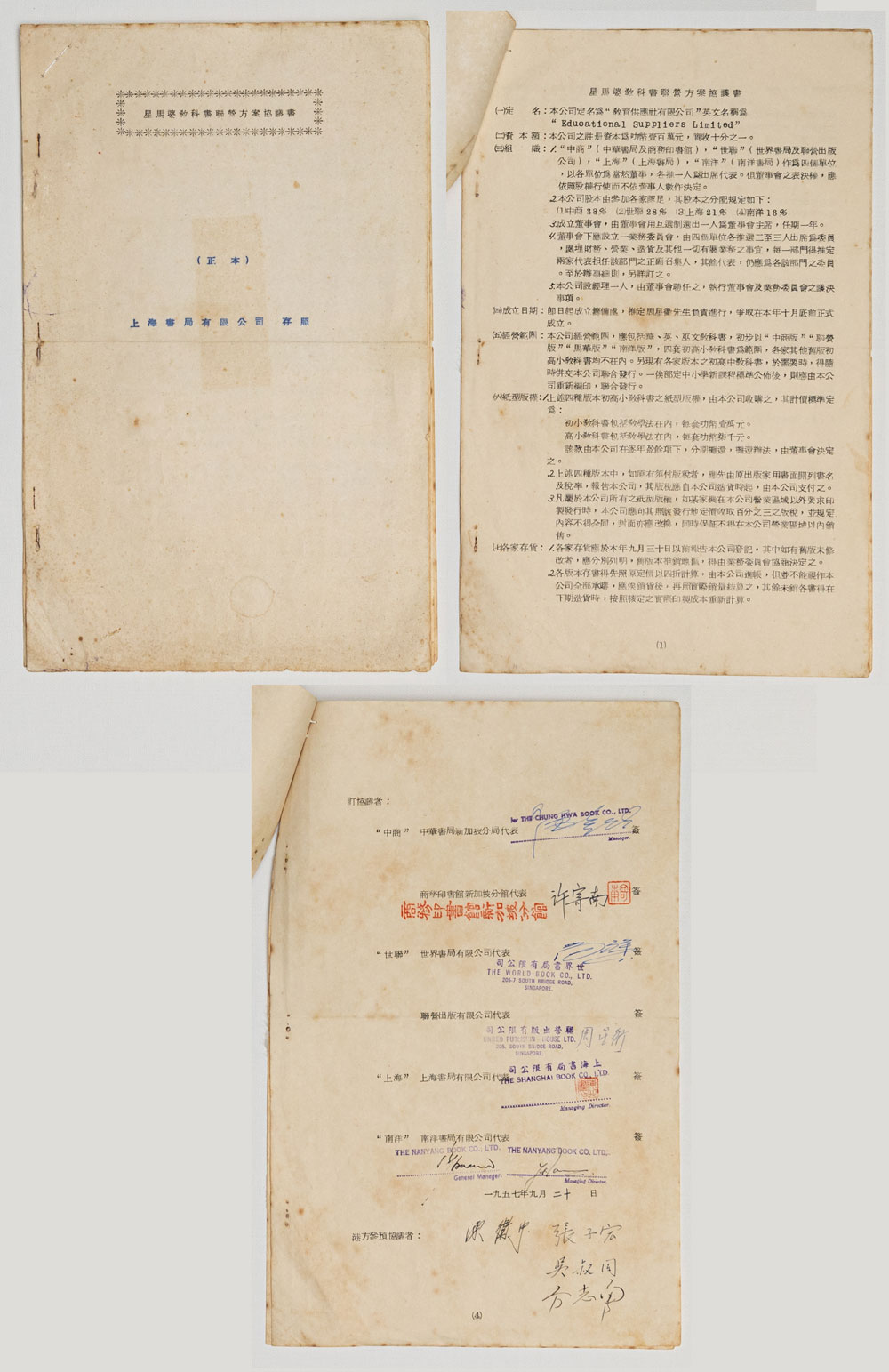 |
Material dating from 1945 to 1983 related to the Shanghai Book Company, such as meeting minutes, correspondence, statement of accounts, contract agreements, trademark registration certificates, photographs of key stakeholders and publication catalogues. Donated by The Shanghai Book Company (Pte.) Ltd. (Total number of donated items: 85) |
The Shanghai Book Company (Pte.) Ltd was founded in Singapore in 1925 and was a major bookseller and publisher in Singapore with branches in Malaya, Indonesia, Hong Kong and other parts of Southeast Asia. It closed its business in Singapore in 2009 and the Kuala Lumpur branch also ceased operations years later. One significant item donated is the 星马婆教科书联营方案协议书 (Contractual Agreement for textbook publishing in Singapore, Malaya and Borneo). This is the original copy of the contractual agreement between the six prominent Chinese publishers in Singapore – The Commercial Press, Chung Hwa Book Company, World Book Company, Nanyang Book Company, United Publishing House, and The Shanghai Book Company. In 1957, they agreed to a consortium by setting up Educational Suppliers Limited, and co-published Chinese school textbooks for Chinese schools in Singapore, Malaya and Borneo. This was a milestone in Chinese publishing history that local publishers came together to standardise the writing of textbooks according to the guidelines issued by the government. |
|
8 |
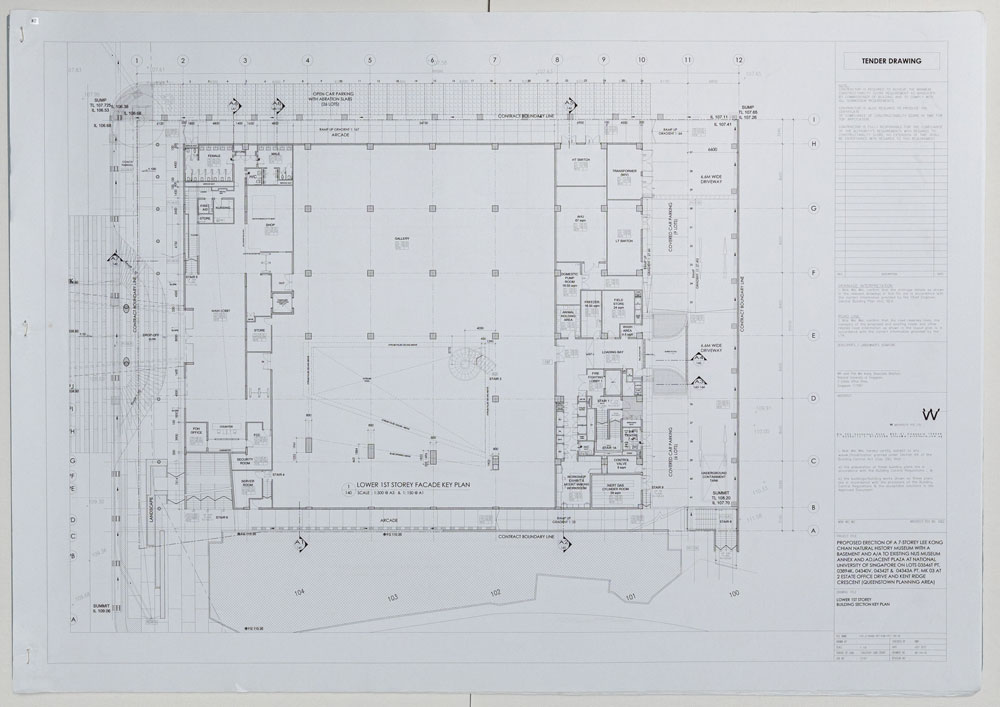 |
Architectural drawings and plans of buildings such as Church of Our Saviour, Tampines North Community Centre, The Patterson Edge, The Oliv, Lee Kong Chian Natural History Museum, as well as the refurbishment of National Museum of Singapore and the renovation of Victoria Theatre and Concert Hall. Donated by William Lim Associates and W Architects Pte Ltd. (Total number of donated items: 426) |
The architectural drawings and plans are from projects that the architecture firm W Architects and its predecessor William Lim Associates have undertaken since the early 1980s. As such, the collection captures the design language of the firm and allows the documentation of Singapore’s built heritage, shedding light on the thought process of architectural design and planning. The collection includes a set of tender drawings of the Lee Kong Chian Natural History Museum, located within the National University of Singapore. W Architects Pte Ltd won an open competition to design this institution which houses the Zoological Reference Collection. The project took the firm four years (2011 to 2015) to complete. The building is known for having distinctive architectural features including having a façade that resembles a "moss-covered rock". To soften this austere appearance, part of this façade was cleaved to reveal a hanging garden that references the sea cliffs of coastal Singapore. |
|
9 |
 |
Collection of photographs of scenes and views of Singapore and Pulau Tekong, taken between 1980 and 1984. Donated by Mr Tan Oh Hee, the photographer of the photos. (Total number of donated items: 68) |
This collection of photographs provides a visual documentation of Singapore scenes in the early 1980s, some of which have disappeared or have undergone further development in the last few decades. It includes photographs of Pulau Tekong taken in 1984 before the resettlement of the island's residents to mainland Singapore and its conversion into a military training camp. They provide meaningful documentation of life, infrastructure and sights on the island which can no longer be found. There are also photographs showing various views of Changi Airport in 1981, the year it officially opened. They include views of the Changi Airport Terminal 1 building and the expanse of undeveloped land beyond it that would eventually be part of an expanded Changi Airport. |
|
10 |
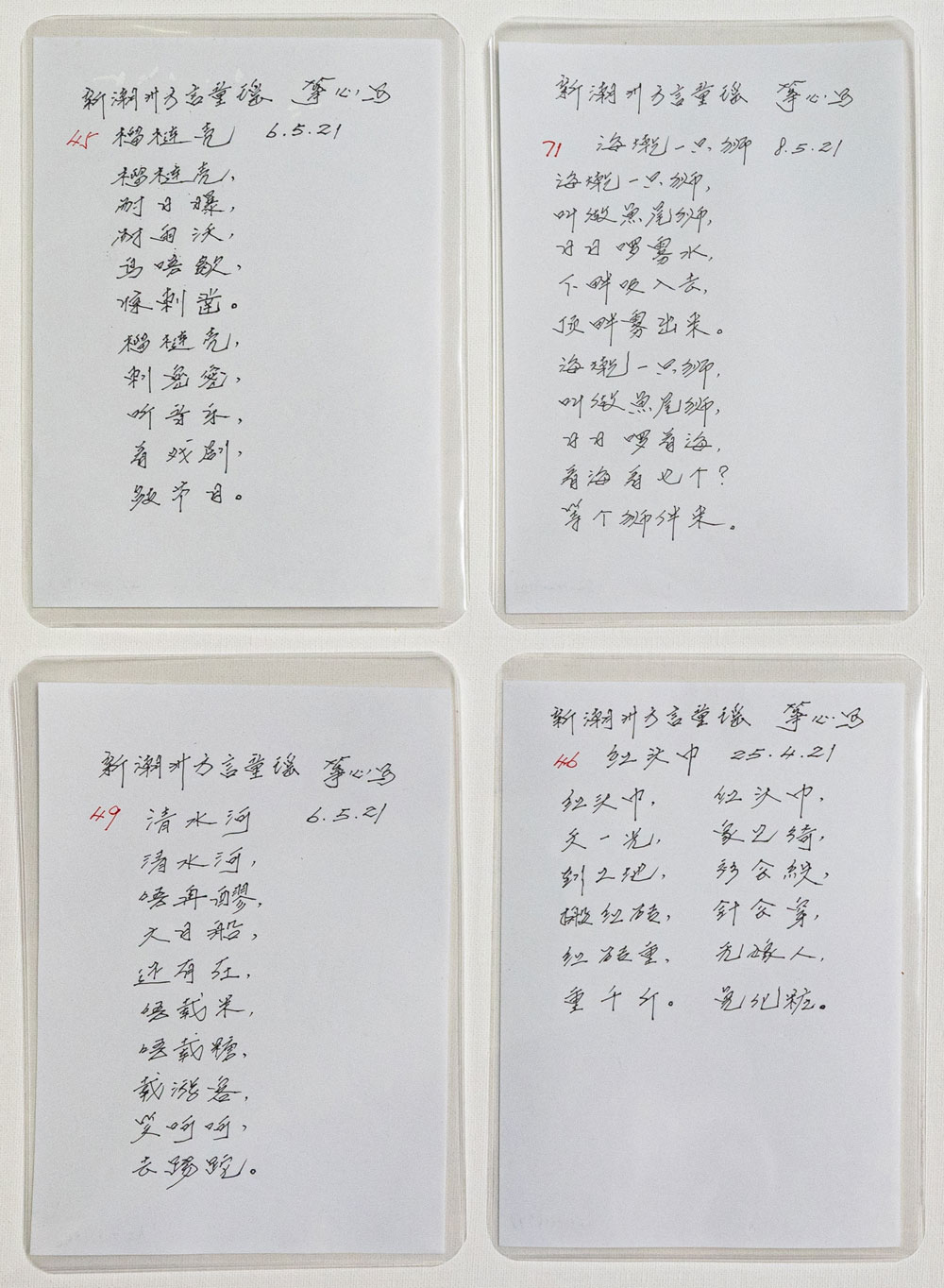 |
Manuscripts of Teochew nursery rhymes written by Mr Chua Hong Siang from 2018 to 2020, covering Singapore history themes. Donated by Mr Chua Hong Siang, a Chinese author who has published books on nursery rhymes, fables, poems, and children’s songs. (Total number of donated items: 100) |
Through the rhymes, Mr Chua talks about the changes in Singapore from pre-independent years to modern day. They cover a range of topics, familiar places and people such as the Singapore River, Esplanade, Merlion and Samsui women. The rhymes, narrated by Mr Chua, are also found online on SoundscapeSG, an initiative by NAS to preserve the sounds of Singapore. |
|
11 |
 |
Documents, letters, newspaper clippings and photographs belonging to the late Mr Goh Kok Siong, who worked for the Malayan Police in 1948. Donated by Ms Pei Pei Goh Kim Ling, granddaughter of Mr Goh Kok Siong. (Total number of donated items: 42) |
The donation includes a document of the First Criminal District Court of Singapore which recorded the case between Mr Goh Kok Siong and two police detectives who with other detectives had assaulted Mr Goh at the Central Police station in 1943 during the Japanese occupation of Singapore. This court document of 2 January 1947 detailed the circumstances leading to the assault, Mr Goh’s statement about the accused and the decision of the presiding Judge. |
|
12 |
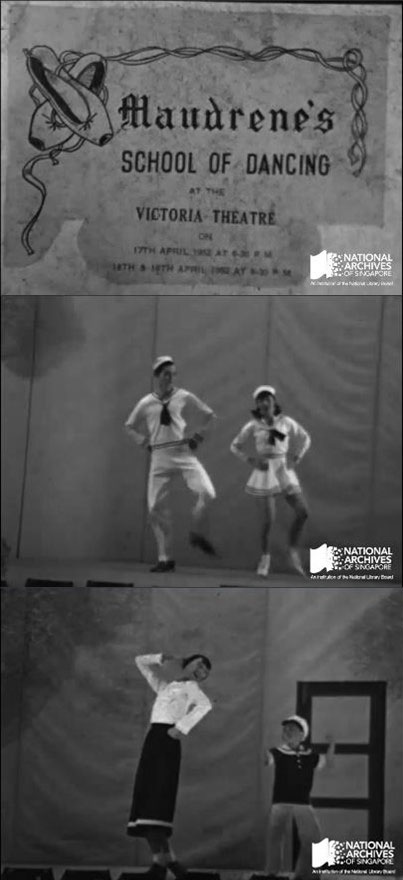 |
Collection of film reels and photo slides taken in the 1950s belonging to the late Mr Patrick Lim Chor Ann. Donated by Mdm Lim Pey Rong Charlotte, daughter of Mr Patrick Lim Chor Ann. (Total number of donated items: 20) |
The collection provides insights into the social history and performing arts scene in Singapore during the 1950s. One of the film reels is a recording of a performance by students of Maudrene Yap’s School of Dancing at Victoria Theatre on 17 April 1952, directed by Ms Maudrene Yap herself, with photography by the donor’s father and Mr David Ng. Ms Yap was one of Singapore’s pioneers in dance and performing arts. The recording of the performance in Maudrene Yap’s School of Dancing at Victoria Theatre was reported in the newspapers in the 1950s. The film reel also appears to be an edited and finished short movie complete with titles and credits, instead of a series of raw footage. |
|
13 |
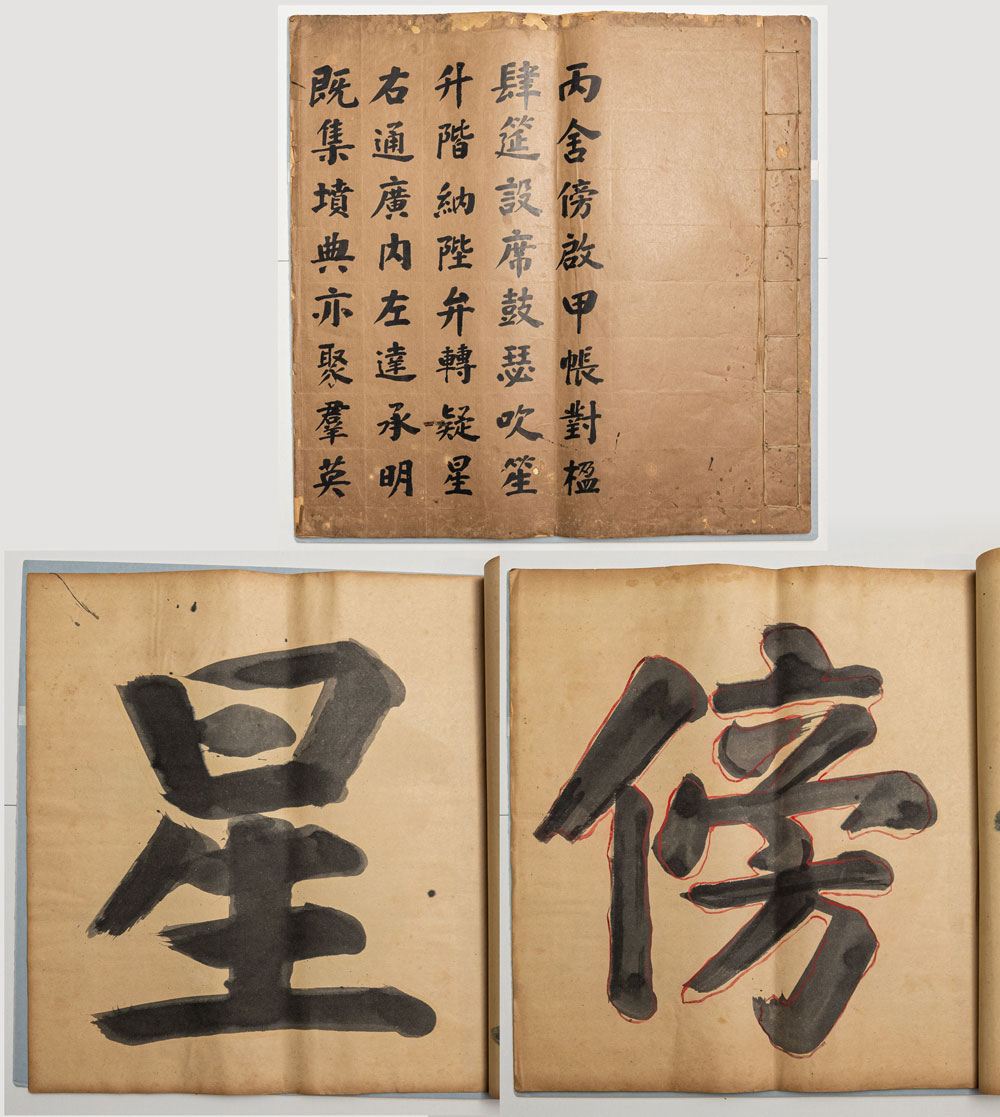 |
Compilation of calligraphies by Mr Xu Yunzhi, one of the pioneer calligraphers in Singapore. Donated by Mr Koh Kok Chin, grandson of Mr Xu Yunzhi (Total number of donated items: 101) |
Mr Xu Yunzhi was known for his calligraphy and carved seals and was often asked to write calligraphies to be carved into plaques. His calligraphies can be found on the plaques at places such as the Chung Hwa Medical Institution, Haw Par Villa and Hwa Chong Institution. One significant item is the compilation of Mr Xu's calligraphy. Before his death in 1960, he compiled booklets of his calligraphy of different characters. According to the donor, Mr Koh, this is such that those who would like to use his calligraphy for plaques after his passing could extract the required calligraphy from these booklets. |
